Luffa cylindrica

Taxonomy:
Kingdom: Plantae

Division: Mangoliophyta
Class: Mangoliosida Order: Cucurbitales
Family: Cucurbitaceae Genus: Luffa Species: cylindrica


Chromosome No. 2n= 26
Common Name: Smooth gourd, loofah, vegetable sponge, bath sponge, dish cloth gourd, Egyptian cucumber, Vietnamese luffa, Ghia tori/Gilki/ Chikni Turai (Hindi), Tuppada heerekayi (kannada), Jhinga (Bengali), Janhi (Oriya), Neti Beerakaya (Telegu), Peechinga (Malayalam) and Pirkanga (Tamil).

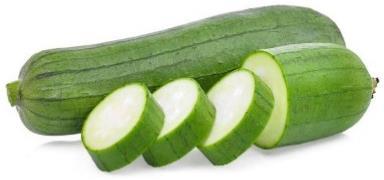
Origin and distribution
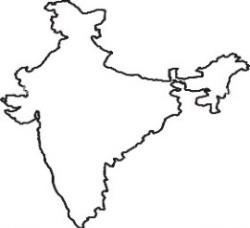
Luffa is an old-world genus comprising of nine species in the world, out of these seven species namely, Luffa acutangula, L. cylindrica, L. echinata, L. graveolens, L. hermaphrodita, L. tuberosa and L. umbellate are originated in Asian sub-continent. Genus Luffa is originated in subtropical Asian region particularly India. Hence, India is considered as primary centre of origin, it is mainly cultivated in India, Southeast Asia, China, Japan, Egypt and some parts of Africa. The genus Luffa consists of two cultivated species viz., ridge gourd (L. acutangula Roxb.) and sponge gourd (L. cylindrical Roem.), while, L. hermaphrodita a pheral form of L. acutangula is semi cultivated species in Eastern India Sponge gourds are grown as mixed cropping in the river beds and as mono crop in the garden lands, in India, it is cultivated in the states of Uttar Pradesh, Punjab, Bihar, Jharkhand, Gujarat, Rajasthan, Haryana, Delhi, Andra Pradesh, Tamil Nadu, Karnataka, Maharashtra, Assam and West Bengal.
Economic importance
Cultivatedbothonacommercialscaleandinkitchengardensthroughout India,the tenderfruits of sponge a gourd are popular well-known culinary vegetable in India with good nutritive value It is a good source of carbohydrates, vitamins ‘A’ and ‘C’ and contains moisture 93.2 g, protein 1.2 g, fat 0.20 g, carbohydrate 2.9 g, B vitamins (Thiamine 0.02 mg, Riboflavin 0.06 mg, Niacin 0.4 mg and Carotene 120 mg), minerals (Calcium 36 mg, Phosphorus 19 mg and Ferrous 1.1 mg), fibres 0.20 g per 100 g of edible portion and gelatinous compound called luffein Fibre of mature dry fruits is used as a bath sponge, scrubber pads, doormats, pillows and mattresses and also for clearing utensils. As tender fruits are easily digestible and appetizing, it is prescribed for those who are suffering from malaria and threptic agent used for AIDS.

Products



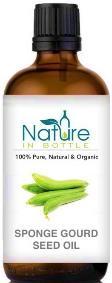
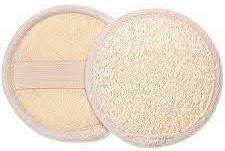



Morphological characterization: It is a cross-pollinated crop widely cultivated during kharif and summer seasons in India and Sponge gourd is an annual climber monoecious vegetable, but different sex forms like hermaphrodite, staminate, pistillate etc., are commonly found. The flowers are yellow in colour, anthesis takes place in the morning between 4.00 to 8.00 A.M. The skin of sponge gourd is smooth and green, seeds are white and black with smooth surface. There is wide variability in size (ranging from a few centimetres to one meter long), shape and colour of fruits.

Anatomy Flower

Stem cross section

Varieties
Developing
institutions Variety/ Genotypes special feature

IARI, New Delhi. Pusa Chikni
Early variety. Fruits smooth dark green and cylindrical, 15-20 fruits / plant.
IARI, New Delhi. Pusa Supriya
Fruits pale green, 15-20 cm long, straight and slightly curved at stem end, pointed distal end with long peduncle, average fruit weight 110 g at vegetable harvest stage. Yield 10-11 t/ha.
IARI, New Delhi. Pusa Sneha
Suitable for long distance transport, fruits dark green, 20-25 cm long with hard skin and soft flesh. Maturity 50-55 days. Yield 12 t/ha. Suitable for cultivation in
Fruit
IIVR, VARANASI Kashi Rakshita
both spring summer and kharif seasons.
Vine length 3.5 to 5 m, fruit colour dark green, 1st male flower appears on 4-6th node while 1st female flower appears on 8-10th node. Average number of fruits/plant ranges from 1214. Fruits become ready to harvest at 48-52 days after sowing. Resistance to disease downy mildew and sponge gourd Mosaic Virus under field condition
IIVR, VARANASI Kashi Shreya
Vine length 3 to 5.5 m, fruits cylindrical and dark green. Plants starts flowering at 45 days after planting. Fruit diameter 3-3.75 cm and fruit weight 100 to 150 g. Fruits starts maturing after 105115 days. Resistance to downy mildew, Powdery mildew and Sponge Gourd Mosaic Virus under field condition. Tolerant to leaf minor, fruit fly and red pumpkin beetle. Suitable for river bed cultivation
IIVR, VARANASI Kashi Divya
This is the first variety having medium sized, attractive and cylindrical fruit with high yield potential which is suitable for distant marketing. It can be grown successfully in rainy and summer seasons and performs better at 25300C at medium humidity. Yield 250-270 q/ ha
IIVR, VARANASI Kashi Saumya (VRSGH-3) F1 Hybrid
Medium maturing hybrid, attractive dark green medium fruits. This is suitable for river bed cultivation. Resistant to Sponge Gourd Mosaic Virus and tolerant to Downey and Powdery Mildew under field condition. Higher yield
MPAU, Rahuri. Phule Prajakta
BAC, RAU, Sabour, Bihar Rajendra Nenua 1
Bellary local BEL-2
Davanagere local DVG-2
Dharwad local DWD-1
Dharwad local DWD-2
Hubli local HUB-6
Hubli local HUB-10
Mudigere local MUD-1
Sringeri local SG-1
Sringeri local SG-5
COH, Arabhavi KRCCH-3
Hunasi local HUNL
Sirsi local SIRL
Yadagiri local YADL
Kudligi local KUDL
Maharashtra local MHL
Mysore local MYSL
(185-195q/h) more than 30 % over the check variety
Fruits medium green with dark green sutures, yield 15 t/ha.
Fruits long, greenish white, smooth and thick, resistant to fruit fly and fruit rot. Yield 25 t/ha.
Fruits smooth green and elongate slim, yield 7.45-8.2 t/ha
Fruits smooth dark green and elliptical, yield 8.04-9 t/ha
Fruits green and elongate slim, yield 5.92-7 t/ha
Dark green and elongate elliptical 7.8 5 t/ha
Light green and elongate elliptical, yield 6.79-7 t/ha
Green and elongate slim, yield 7.48-8 t/ha
Green and oblong blocky, yield 7.73-9 t/ha
Dark green and elongate slim, yield 9.42-10 t/ha
Light green and oblong blocky, yield 8.79-9 t/ha
Dark green and elliptical, yield 6.01-8 t/ha
Green and elongate elliptical, yield 6.92-7 t/ha
Green and elongate slim, yield 9.92-10 t/ha
Dark green and elongate elliptical, yield 10.82-12 t/ha
Light green and oblong blocky, yield 6.17-7 t/ha
Green and elongate elliptical, yield 6.64-8 t/ha
Dark green and elongate slim, yield 6.76-9 t/ha
Climate and soil



Like bitter gourd, ridge gourd and smooth gourd are typical warm season crops and come up well during summer and rainy seasons. Optimum temperature required is 25-27 oC. Ideal soil is fertile well drained loam rich in humus. A well drained soil having PH 6.0-7.5.

Cultivation practices

Season: smooth gourd are grown during summer and rainy season by sowing seeds during January –February, June – July and in river beds, in northern India, sowing is done in November–January respectively.
Preparation of land and Seed rate
Seeds are sown in raised beds, furrows or pits @ 3.5-5.0 kg/ha for ridge gourd and 2.5-5.0 kg/ha for sponge gourd. Since seeds are with hard seed coat, it is advisable to soak seeds overnight in water.

Spacing:
A row-to-row distance of 1.5-2.5 m and hill to hill distance of 60-120 cm is required for both crops under bower or trellis system. When it is trailed to ground under pit system, a row-torow spacing of 1.5-2.0 m and pit-to-pit distance of 1.0-1.5 m are recommended for both crops.

Nutrition:
Farmyard manures at the rate of 15-20 tonnes /ha should be mixed in the soil at the time of preparation of field. The super phosphate, potash and the half nitrogen should be applied as a basal dose and one-half nitrogen should be given as top dressing after one month of planting.

Under Haryana conditions, farmyard manure 10-15 tonnes/ha and 40-60kg N, 30-40kg P705 and 30kg of K2O /ha are recommended for both the crops. In addition to N 20-30kg should be top dressed at the time of vining. In Punjab, 100kg of N, 60kg of P205 and 60kg of K20 /ha is recommended.
Irrigation:

The summer crop must be irrigated regularly. The first irrigation should be given immediately after the sowing. Summer crops require more frequent irrigation than rainy season crops. Irrigation may be carried out according to the soil moisture status and season. During the rainy season, irrigation may be required during the early growth period. No systematic work is done on requirement of irrigation water and its management in these crops.
intercultural operations
a) Weed control:
Weeding should be done 15-20 days after the sowing. The second weeding may be done 20-25 days after the first one. The crop is kept weed free during the entire growth period.



Growth regulators
In these crops, the female and male flowers are borne separately on the same plant. The sex ratio can be regulated by exogenous application of growth regulators NAA (200ppm) increases the female flower production in ridge gourd and in turn increases the yield significantly. In sponge gourd, exogenous application of Ethrel 250ppm has been found to be beneficial.
Training and pruning:
Training and pruning in small homestead gardens, sponge gourd are trailed over trellises arbours or pendals at 1.5-2.0m height. Commercial crop are trained on a kniffen system. The crop is trained when the seedlings are about 10- 15cm tall. The early crop can be allowed to trail on the bed itself. In northern India the crop is generally not trained and the vines are allowed to trail on the ground. Rainy season crop should be staked so that the fruits are prevented from direct contact with the soil. are same as that of bitter gourd.

Harvesting

The crop is ready for harvest in about 60-90 days after the seed sowing, depending upon the season and variety. The fruit attains a marketable maturity about 5-7 days after anthesis of the female flower. Fruits should be harvested when they are still immature. Picking should be done every 3-4 days. If there is delay in harvesting, the fruits become more fibrous and are unfit for human consumption. Fruits are harvested when they are tender and still immature. The flesh should not turn fibrous and picking should be done earlier. The tenderness would decide edible maturity and not the fruit size.
Yield
Average yield of sponge is 8-12 tonnes/ha. Hybrid: 20-25 tones/ha. Grading according to the size. Packed in bamboo baskets with cushion Store in cool place for 3-4 days

Storage and marketing
Harvesting should be done at proper edible maturity. Grading of fruits should be done according to size. The fruits are packed in separate baskets. Care should be taken that the fruits should not have any injury during transit. The fresh and tender fruits should reach the consumer. Fruits harvested at the marketable stage can be stored for 3-4 days in a cool place without any adverse effects. The fruits are packed in bamboo baskets with proper padding to prevent injury in transit. The fruits are marketed in local and distant markets. The plastic crates are also used for packing of fruits.
Pests and Diseases of sponge gourd and other cucurbits crops
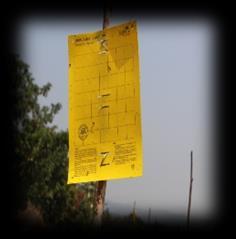
Pests
Fruit fly, red pumpkin beetle and epilachna beetle cause damage to most of cucurbits. In addition, insects like gall fly; aphids, leaf hopper, ants, worms, underground semi loopers, leaf miners,fruitborersandmitesaffectspecificcucurbits.Intensityofinfestationvaries fromplace to place.

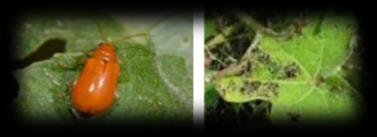
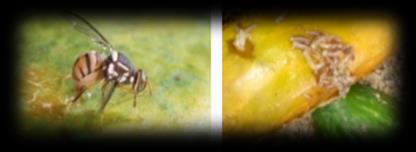
Fruit fly (Bacterocera cucurbitae)
This is amajorpest ofmajorityofcucurbits especiallythatofbittergourd,snakegourd,pointed gourd, muskmelon, oriental pickling melon, watermelon, tinda and pumpkin. Adult fly has reddish brown body with transparent and shiny wings, bearing yellow-brown streaks. It lays eggs singly or in clusters of 4-12 in flower or developing fruits or ripening fruits with the help of sharp ovipositor of females. Eggs hatch in 2-9 days and maggots feed on internal contents of fruits causing rotting. Pupation is in ground at a depth of 1.5-15.0 cm. Infestation is more during rainy season. Adopt following package for control of fruit fly: 1. Cover developing fruits with papercoveror polythenecoverimmediatelyafteranthesis and pollination. 2. Collect and destroy affected fruits by dipping in hot water or insecticide solution. Do not leave infested fruits on gourd. 3. Use light trap and poison baits during night. Spray a bait solution containing 200 g gur or sugar and 20 ml Malathion 50 EC in 20 1 of water as coarse droplets on lower surface of leaves. 4. Spraying on under surface of leaves of maize plants grown in rows at a distance of 8-10 m in cucurbit field is also effective as flies rest on such tall plants. 5. Hang baits containing sex attractants like pheromones or protein hydrolysate with Furadan granules. Hanging coconut shells with pieces of fully ripened fruits of “Mysore poovan” banana or toddy or molasses along with Furadan granules also attract and kill fruit flies.
Red Pumpkin Beetle (Aulacophora foveicollis)
Beetle attacks most of cucurbits especially melons, bottle gourd, pumpkin, cucumber, water melon etc. Bitter gourd is not seen attacked by beetle. Beetles eat the leaf lamina causing defoliation particularly at cotyledon stage of crop. Grubs feed on underground stem and root portion of plants causing holes / galleries and result in drying up of plants. As insects pupate in the soil, deep ploughing soon after the crop exposes and kills grubs and pupae. Application of Furadan 3 G granules 3-4 cm deep in soil near base of just germinated seedlings will take care of young seedlings from attack of beetle. Epilachna beetle (Epilachna seplima) Epilachna beetle is a serious pest of bitter gourd and snake gourd. Adult flies feed on foliage causing holes and defoliation. A large number of yellow-coloured thorny grubs are seen on under surface of leaves and feed on chlorophyll resulting in skeletonization of leaves. Mechanical control by way of collection and destruction of egg masses and grubs are very effective as they are seen as a colony. It can also be controlled by spraying Carbaryl (0.2%) or Metacystox (0.15%).
Aphids (Aphis gossypii)
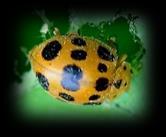
Aphids suck sap from leaves of cucurbits like ash gourd, snake gourd, mush melon, water melon, cucumber etc. causing crinkling ofleaves. It also transmits mosaicvirus.Control aphids by spraying Malathion (0.1%) or tobacco decoction
Leaf hopper (Amrasca biguttula biguttula)

During summer months, jassids cause heavy loss to bitter gourd crop. Green coloured hopper and its nymphs are seen in large numbers on under surface of leaves and suck sap causing typical hopper burn symptoms. Initially neem oil garlic mixture at fortnightly interval is effective for control of hopper. Spraying of Acetaf, Imidachloprid etc. control hoppers effectively.
Red spider mites (Tetranychus sp.)

Larvae, nymphs and adults of mite’s lacerate leaves from under surface and suck sap resulting in production of white patches between veins in Cucumis melo. Infested leaves turn yellow and fall of prematurely. In severe cases, intense webbing occurs giving a dustyappearance to under surface of leaves. Mites can be controlled by spray of neem oil garlic mixture or Kelthane or Dicofol on under surface of the leaves.

Leaf miner (Lyriomyza trifolii)
This polyphagous pest causes characteristic white twisting lines in ash gourd, Cucumis sativus and Cucumis melo. Severe leaf mining accelerates leaf drop and retards growth and yield of plants. Mated females puncture leaves and lays eggs in leaf tissues. After hatching, larvae start feeding in palisade mesophyll cells of leaves while moving inside. Mines start from margins of leaves and progress towards centre. Yellow larvae can be seen at the end of mines. Larval duration is 4-6 days. When larva is ready to pupate, it cuts a semi-circular slit on leaf surface and fall down on ground. Larvae emerge from leaves during early morning before 8.00 a.m. For control of miner, trap adults to yellow cards applied with adhesives. Burning infested dried leaves will help in reduction of population. Spraying neem oil garlic mixture early in morning before sunrise will be an effective control.
Gall fly (Lasioptera falcate)
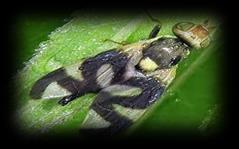
Gall flies, having shape of mosquitoes, lay eggs in soft stem of bitter gourd, snake gourd, coccinia etc. Emerging larva feed inside stem. Since large numbers of larvae are seen inside stem, affected portion becomes bulged and subsequent growth of stem is arrested. Restrict irrigation and nitrogen fertilizers once infestation is noticed. Cutting and removal of galls also should be practiced regularly. Spray systemic insecticides under sever infestation.


Diseases
Fusarium wilt (Fusarium oxysporum)
Fusarium wilt is a serious disease water melon, musk melon, bottle gourd etc. In young seedlings, cotyledons drop and wither. Older plants wilt suddenly and vascular bundles at the collar region show brown discolouration. Being a soil borne disease, chemical control is very difficult. Cultivation of resistant varieties and crop rotation with resistant crops are viable methods for overcoming the disease. To some extent, the disease can be checked by hot water treatment of seeds at 55o C for 15 minutes and by drenching soil with carbendazim.
Collar
rot (Rhizoctonia solanii) / Pythium rot (Pythium sp.)
Characteristic symptom of the disease is appearance of dark brown water-soaked lesions girdling the base of stem at soil level followed by death of plants. It is more serious under water
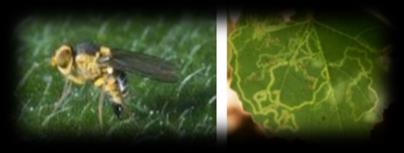
logged conditions and during rainy seasons. Treating seeds with Thiram @ 3 g/kg of seed before sowing, sowing of seeds on raised beds, drenching vines with Ridomil (0.2%) or Carbendazim (0.1%) are recommended for control of the disease.
Powdery mildew (Sphaerotheca fuliginea)
This disease is more destructive in pumpkin, squashes, bottle gourd, melon and cucumber, that too, during rain free periods. Symptoms appear as white to dirty grey spots or patches on leaves which become white powdery as they enlarge. Powdery coating covers entire plant parts and causes defoliation. Fortnightly spray of Karathane (0.5%) or Calixin (0.05%) or Carbendazim (0.1%) are recommended for control of powdery mildew.



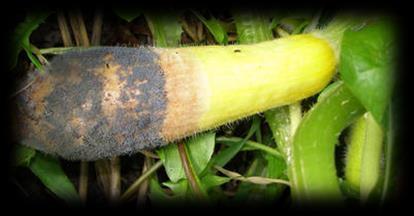
Downy mildew (Pseudo Peronospora cubensis)
Disease is prevalent in areas of high humidity, especially during rainy season, on crops like bitter gourd, snake gourd, melon, bottle gourd and ridge gourd. Symptoms appear as watersoaked lesions on under surface of leaf lamina and angular spots on upper surface corresponding to the water-soaked lesions on under surface. Disease spreads very fast. Plucking and destruction of affected leaves and spraying Dithane M-45 (0.2%) on under surface of leaves give effective control.
Anthracnose (Colletotrichum lagenarium)
This disease is endemic in warm and humid conditions where rainfall and humidity are high. Cucurbits like watermelon, bottle gourd, cucumber and snake gourd are more susceptible to disease. Different types of symptoms are observed on leaves, petioles, stem and fruits. Symptoms on young fruits appear in the form of numerous water-soaked depressed oval spots, which coalesce covering large areas. Under humid conditions, pink masses of spores can be seen in centre of these spots. Pink gummy exudation may also be seen on lesions due to exudation of spores. Symptoms on vines occur as brownish specks which grow into angular to circular spots. Girdling of affected portion leads to general blight symptoms. Clean cultivation and crop rotation minimize disease incidence. Treating seeds with Carbendazim @ 25 g/kg of seed and spraying crop at 10 days intervals with Indofil M-45 (0.35%). Benomyl or Carbendazim (0.1%) gives effective control.
Alternaria blight and fruit rot (Alternaria cucumerina)
This is a serious disease under warm and humid conditions in crops like musk melon, water melon, bottle gourd, snake gourd, cucumber and pumpkin. Symptoms appear as yellow spots on leaves which turn brown and finally turn black on aging. They usually start from margins and produce concentric rings. Severely affected vines look like burnt charcoal. Use of diseasefree seeds, clean cultivation and crop rotation are effective for control of disease. Spray of 0.25% Indofil M-45 at 10-15 days interval is effective for disease control.


Mosaic
Viral disease are causing extensive damage to different cucurbits like pumpkin and squashes, water melon, ridge gourd, bitter gourd, ash gourd, melon, cucumber and coccinia. Viral diseases are becoming serious due to intensive and continuous cultivation of a crop with indiscriminate use of plant protection chemicals. Several viruses like aphid transmitted cucumber mosaic virus, watermelon mosaic viruses like aphid transmitted cucumber mosaic virus, watermelon mosaic virus, mechanically transmissible tobacco virus group, non sap transmissible but white fly transmissible yellow vein mosaic virus etc. cause malformation and damage to plants. Symptoms expressed by host plant vary with virus and crop. Mosaic mottling, curling and twisting of leaves, shortening of internodes, stunted growth are common symptoms and vegetative growth, flowering and productivity are adversely affected once crop is infected. Complete control of the diseases is not possible. Adoption of practices like collection of seeds from healthy virus free plants, seed treatment with hot air (70o C for 2 days) orhotwater(55oCfor60minutes),cleancultivationandremovalofalternatehostsparticularly weeds, avoiding relay cropping of susceptible crops, prophylactic spray of organic pesticides, control of vectors by spraying insecticides, use of biocontrol agents, cultivation of tolerant / resistant varieties, avoiding cropping during mosaic prone season and areas, either alone or in combination have to be tried for raising a mosaic free crop. Selection of methods for control of viral diseases should be based on intensity of infection, mode of transmission, etc.
Nematodes
Cucurbits are highly susceptible to nematode infestation particularly of root knot nematode Meloidogyne incognita acrita. Symptoms include premature leaf fall, wilting and decline in growth and fruit production. Roots of infected plants show typical galls / knots. Cultivation of resistant varieties, crop rotation with non-host plants, successive deep ploughing during hot
weather, soil solarization with polythene sheets and soil fumigation with nematicides are advocated for control of root knot nematode.
Fig 1. Leaf shape
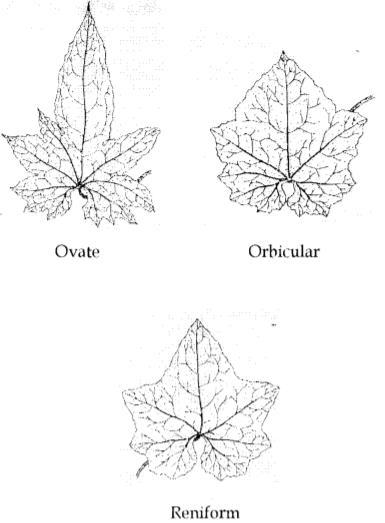
Fig 2. Fruit shape


Fig 3. Stem end fruits shape
Fig 4. Blossom end fruit shape

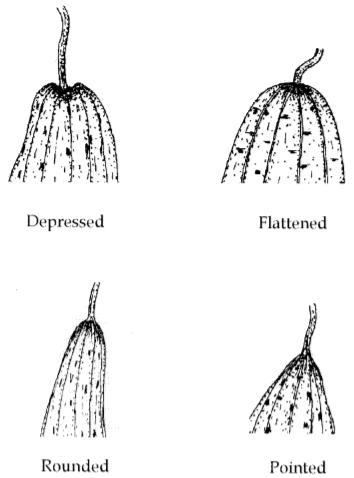 EDITED BY: PURUSHOTTAMA K
EDITED BY: PURUSHOTTAMA K
M.Sc. (HORT.) Genetics and Plant Breeding
























































 EDITED BY: PURUSHOTTAMA K
EDITED BY: PURUSHOTTAMA K